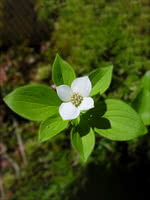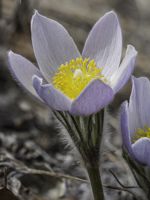Mon-Fri 9am - 5pm Mountain time
Bunchberry vs Prairie Crocus
Cornus canadensis
Pulsatilla nuttalliana (Anemone patens)
NOT AVAILABLE THIS SEASON - MIGHT RETURN
NOT AVAILABLE THIS SEASON - MIGHT RETURN
The Bunchberry, or Quatre-Temps as it is commonly known in Quebec, is an excellent ornamental plant to have in your garden. With star-shaped white flowers in spring and clusters of bright red berries in the fall, this is one of the most refined and hardy groundcovers available. The foliage has ornamental value, with leaves going from a deep green in the spring and summer to a beautiful brick-red in the fall.
Bunchberry is a spreading evergreen perennial with a ground-hugging habit of growth. This plant is not well suited for urban areas close to streetsides, as it is quite intolerant to pollution. It is Canada’s national flower.
According to a poll done by the Master Gardeners of Ontario, it is one of the most recognizable Canadian flowers.
Its flowers grow with elastic petals and "fire" its pollen with the force of 2000-3000 times the force of gravity.
Prairie Crocus is a native perennial wildflower that is often considered one of the first signs of spring. The flowers can range from purple, pale blue, to white and often appear before the snow has fully melted. It can bloom a month earlier than other spring flowers, providing an early source of pollen for a variety of pollinators.
The plant is covered in woolly white hairs, including the finely divided leaves, giving them a silvery appearance. Prairie Crocus leaves do not fully emerge until after it has bloomed. The spent blooms transform into fluffy, feathery seed heads. During the hot summer months, the Prairie Crocus goes dormant and will repeat its life cycle the following spring.
The Prairie Crocus is Manitoba’s provincial flower.
Bunchberry Quick Facts
Prairie Crocus Quick Facts
Toxicity: all parts toxic if eaten, sap can irritate skin

